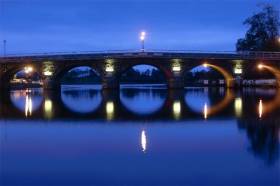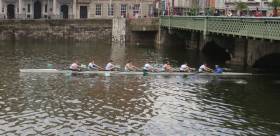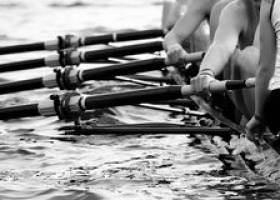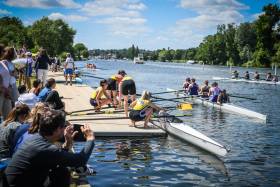Displaying items by tag: commercial
Commercial Senior Eight Resist Strong UCD Challenge
#Rowing: Commercial beat UCD and Cork Boat Club to take the men's eights at Skibbereen Grand League Regatta at the National Rowing Centre today. Commercial seemed to be in a commanding lead coming up to the viewing area, but UCD chased them down and were under two seconds behind at the finish, with Cork not much further back.
The women's eights went, as expected, to UCC, while Holly Davis, who is just 14, won the Division Two single sculls by a huge margin.
#Rowing: The Afloat Rowers of the Month for April are the Enniskillen girls’ and boys’ junior 18 eights which won at Commercial and Neptune regattas, respectively. The young women won the final race at Commercial, beating the hosts in a fine contest which drew the curtain on more than two days of action at Islandbridge. Enniskillen’s boys’ junior 18 eight had beaten Coláiste Iognáid at Neptune regatta on the Saturday.
Enniskillen’s fine run recently has included outstanding placings in the Schools’ Head of the River in London, where the girls placed fourth and the boys sixth – and sixth fastest overall.
Rower of the Month awards: The judging panel is made up of Liam Gorman, rowing correspondent of The Irish Times and David O'Brien, Editor of Afloat magazine. Monthly awards for achievements during the year will appear on afloat.ie. Keep a monthly eye on progress and watch our 2019 champions list grow.
UCD Women Win Close Eights Final at Neptune Regatta
#Rowing: Commercial and UCD took the senior eights titles at Neptune Regatta in different fashions. Trinity's women's eight led UCD passing the Neptune boat house, but UCD fought hard and passed their great rivals to win by a canvas. Commercial beat UCD by one a half lengths in the men’s race.
On a cool, sunny day, Enniskillen boys competed in numbers – their girls will take part in Sunday’s Commercial Regatta – and had a set of good wins, the pick of them being a three-length win over Colaiste Iognaid in the men’s junior 18 eight.
In a battle of two strong junior 18 quadruples, Three Castles beat Neptune, while Trinity won the club one eight, also beating the hosts.
Two Neptune men, twin brothers Ronan and Colum Brennan, fought it out in the men’s junior singles, with Ronan coming out on top.
Rhiannon O’Donoghue of Killorglin beat Commercial’s Katie Dolan in the women’s club one single – Dolan had earlier won the senior single.
Neptune Regatta, Islandbridge, Saturday (Selected Results)
Men
Eight, Sen: Commercial bt UCD 1 ½ l. Club One: Trinity bt Neptune 3l. Novice: UCD bt Trinity A canvas. Jun 18: Enniskillen bt Col Iognaid 3l. Jun 16: Col Iognaid bt Blackrock 3ft.
Four – Club One, coxed: Enniskillen bt Neptune Jun 18, coxed: Enniskillen B bt Enniskillen A 2½ l. Masters, coxed: Commercial, Belfast BC, Galway bt Neptune.
Sculling, Quadruple – Club Two, coxed: Fermoy A bt Neptune 1l. Jun 18: Three Castles bt Neptune. Jun 18, coxed: Enniskillen A bt Enniskillen B. Jun 16, coxed: Cork. Double – Jun 16: Athlone bt Neptune A. Single – Sen: New Ross (Kennell-Webb bt Portadown (Laivins). Club One: Enniskillen (N Timoney) bt Enniskillen (J McDade) easily. Club Two: Trinity (Dennis) bt Carlow (Bolton-Dowling) . Jun 18: Neptune (R Brennan) bt Neptune (C Brennan) easily. Jun 16: Carlow (D Nolan) bt Neptune (A Gillick) easily.
Women
Eight – Sen: UCD bt Trinity canvas. Club One: UCD A bt Neptune. Novice: Trinity A bt Neptune 3l. Jun 16: Castleconnell bt Methody easily. Masters (G) Old Collegians bt Commercial, Belfast BC, Galway. E: Tribesmen A bt Neptune.
Four – Sen, coxed: Killorglin bt Akademiska Roddforeningen 2l. Club One, coxed: Commercial bt UCD B. Jun 18: Col Iognaid bt Carlow easily.
Sculling, Quadruple – Club Two, coxed: Killorglin bt Trinity easily. Jun 18: Athlone bt Graiguenamanagh easily. Jun 16, coxed: Col Iognaid bt Castleconnell.
Double – Jun 16: Shannon A bt Clonmel 3l.
Single – Sen: Commercial (K Dolan) bt New Ross (L Brown) 4l. Club Two: Carlow (Egan) bt Commercial (Norinho) 3l. Jun 18: Commercial (Healy) bt Commercial (Maloney) 2l. Club One: Killorglin (R O’Donoghue) bt Commercial (K Dolan). Jun 16: Three Castles (O’Loughlin) bt Shannon (Hickey).
Commercial and Trinity Shine at Erne Head of the River
#Rowing: The senior eights from Commercial and Trinity topped the men’s and women’s rankings at the Erne Head of the River in Enniskillen today. Commercial were the fastest crew and came home faster than Trinity’s men’s senior eight, while Enniskillen’s junior women’s eight were the second-fastest women’s crew. The host club’s junior 18 men’s eight were also fastest in their class – they were fifth overall.
There were strong winds throughout the race. Despite the conditions, this was the biggest Erne Head.
Erne Head (provisional results); 1 Commercial A men’s senior eight 19 mins 32 seconds, 2 Trinity mens sen eight 19:56, 3 UCD men’s sen eight 20.11.2, 4 Commercial B men’s sen eight 20.14.9, 5 Enniskillen men’s junior 18 eight 20.35.9, 6 NUIG men’s club one eight 20:56.5. 18 Trinity women’s senior eight 22.24.2; 20 Enniskillen junior women’s eight 22:35.8.
Good Day for Shandon and Coláiste Iognáid
#Rowing: The weather held up well for both the Muckross Head of the River and the Head of the Shannon at Carrick on Shannon today.
Shandon’s men’s intermediate eight topped the Muckross provisional rankings at the National Rowing Centre, while their men’s senior quadruple and men’s club eight placed fifth and sixth. UCC’s women’s club eight were the fastest women’s crew.
The Coláiste Iognáid men’s junior 18 eight took the honours at Carrick on Shannon. They competed in the second head, at 2 o’clock, which had the superior weather conditions. Commercial’s men’s senior eight took second.
Commercial Best at Dublin Head of the River
#Rowing: Commercial took first and second at the Dublin Head of the River today. UCD took third. The fastest women’s crew was Trinity's senior eight and Commercial were the fastest women's junior 18 eight. Neptune’s boys formed the fastest men’s junior crew. Seventeen eights competed in the official race, with a number of crews also taking to the water on a time-only basis.
Dublin Head of the River, Saturday (All Eights; Selected Results): Men – Senior Eight: Commercial A 10 minutes 54 seconds. Inter: Neptune 11:35. Club: Commercial 12:53. Junior 18: Neptune 12:05. Masters: Neptune 13:08.
Women – Senior: Trinity 12:57. Intermediate: Trinity 14:07. Club: Neptune 14:19. Jun 18: Commercial 13:45.
#Rowing: Commercial won a stunningly-close race to take the men’s senior eights title at the Irish Rowing Championships today. NUIG/Queen’s had a slight lead ahead of a tightly-packed field early on, but Commercial moved at the 1,000 metres. They could not shake off UCD and the NUIG/Queen’s composite. UCD
finished really fast and almost – but not quite – caught Commercial, who were taking their third consecutive title.
The women’s senior eight went to Skibbereen. Their talented crew, stroked by Denise Walsh, had a clearwater lead over NUIG, who did not give up the fight but finished second. Skibbereen lifted their title haul to eight with the win.
Enniskillen started the evening session with two wins, in the women’s club eight, where Shandon pushed them, and the men’s junior pair, who were imperious in their victory.
The women’s junior coxed quadruple from Workmen’s was similarly impressive – the quality of junior rowing was a remarkable aspect of this regatta.
Another notable aspect was the proportion of wins which went to Cork clubs. Two of the last three titles did not leave the rebel county: UCC finished out their successful programme with a win in the men’s intermediate double through Ronan Byrne and Hugh Sutton, while Selma Bouanane took the last race of the event, the women’s intermediate single, for Fermoy.
Irish Rowing Championships, Day Three (Selected Results)
Men
Eight – Senior: 1 Commercial (S Mac Eoin, C Cunningham, L Cameron, N Beggan, P Moreau, F Groome, M Corcoran, C Dowling; cox: M Crockett) 5:43.18, 2 UCD 5:43.76, 3 NUIG/Queen’s 5:46.82.
Four – Club, coxed: UCC A 6:38.03.
Pair – Inter: Shandon A 6:56.07. Junior: Enniskillen 6:56.199.
Sculling, Double – Inter: UCC 6:32.59. Junior: Castleconnell (R O’Neill, J Desmond) 6:49.97.
Lightweight Single: Skibbereen (A Burns) 7:20.56.
Women
Eight – Senior: 1 Skibbereen (L Heaphy, O Hayes, M Piggott, A McCarthy, N Long, N Casey, A Casey, D Walsh; cox: A O’Neill) 6:28.42, 2 NUIG A 6:33.32, 3 Trinity 6:48.35. Club: Enniskillen 6:48.33.
Four – Inter, coxed: Cork 7:22.36.
Pair – Junior: Fermoy (E O’Reilly, G McGirr) 7:48.69.
Sculling, Quadruple – Junior: Workmen’s 7:01.06.
Single – Inter: Fermoy (S Bouanane) 8:03.25.
Lightweight Single: 1 Lee (M Cremen) 8:06.97
NUIG Take Women's Senior Four Title at Irish Championships
#Rowing: NUIG won the much-anticipated women’s senior four final at the Irish Rowing Championships today. Trinity made the early moves, but NUIG moved before halfway, with Commercial and Cork Boat Club also coming into contention. From there the Galway club took it and won from Commercial by over three seconds. Cork were third.
#Rowing: Two NUIG crews made it through time trials on the first day of Henley Women’s Regatta and will compete on Saturday. In the Championship Eight, NUIG will take on Yale University (scheduled for 2.40), while the Development Coxed Four have been drawn to take on Aberdeen C at 2.04. Tribesmen were allowed only to compete in the time trial of the Championship Eight.
Three Irish crews made their exits: UCD’s eight, the four from Queen’s University and Cork’s Boat Club’s Championship Double. Commercial’s Championship Lightweight Pair have a bye into the semi-final and go into action first on Sunday (10.20).
Henley Women’s Regatta (Irish interest)
Friday
Championship Eight: NUIG made it through Time Trial.
Aspirational Academic Eight: Bath Univ/Bristol Univ bt UCD, 2 ½ l.
Aspirational Academic Four: Exeter Univ bt Queen’s A, nro
Development Coxed Four: NUIG made it through Time Trial.
Championship Doubles: Leander bt Cork A (C Deasy, J Rigothi) 4 ½ l.
#Rowing: Shandon’s intermediate eight were the fastest crew at the Metropolitan Regatta today. Commercial’s intermediate eight scratched, but UCD’s club one eight gave the young Corkmen a good race – until the final few hundred metres, when Shandon flew away. All of the Shandon crew are junior 18 athletes.
As had been the case in the first session, young rowers came home first in race after race in the superb conditions. Lara Brown of New Ross added the Division One single sculls title to the doubles win she had recorded with Shona Tierney.
Metropolitan Grand League Regatta, Blessington, Saturday (Selected Results; course length between 1750 and 1800m)
Men
Eight – Division One: Shanddon (intermediate) 4:57.91, 2 UCD (club one) 5:02.20. Div Two: Neptune (club two) 5:40.496.
Four – Div One: Commercial A (sen) 5:36.26. Four, coxed – Div One: 1 Commercial (sen) 5:55.01, 2 Shandon (jun 18A) 5:55.99, 3 Commercial (inter) 5:56.41; 5 UCD (club one) 6:02.82. Div Two: UCD A (club two) 5:50.77, 2 Shandon (jun 18B) 5:57.32
Pair – Div One: Commercial (inter) 6:07.65, 2 Commercial (sen) 6:14.6. B Final: 2 Castleconnell 6:25.78; 4 Belfast RC (club one) 6:43.92.
Sculling, Quadruple – Div Two, coxed: Shandon (jun 18B) 5:53.59, 2 Neptune (nov) 5:56.17, 3 Neptune (club two) 5:56.73.
Double – Div One: Castleconnell (jun 18A) 5:47.98; 6 Belfast RC (club one) 6:18.11. Div Two: Cappoquin (club two) 6:03.10; 2 Neptune (jun 18B) 6:03.44. B Final: Commercial C 6:44.69. Single – Div One: Shandon (J Dorney; jun 18A) 6:34.78, 2 St Michael’s (D O’Connor; sen) 6:37.81. B Final: Three Castles (T McKnight; inter) 6:47.52; 5 Commercial (J Casey; club one) 7:11.88. Div Two: Neptune (T Orlic; jun 16) 6:47. 76, 2 Clonmel (O’Donnell; club two) 6:49.48, 3 St Michael’s (O’Gorman; jun 18B) 7:00.84.
Women
Eight – Div Two: UCD (club two) 5:57.43; 4 Commercial (jun 16) 6:39.69. Four, coxed – Div Two: Neptune (club two) 6:56.77.
Pair – Div One: Castleconnell (jun 18) 7:14.24.
Sculling, Quadruple – Div Two, coxed: Commercial (jun 16) 6:51.87, 2 Neptune (club two) 6:54.06, 3 Fermoy (nov) 6:54.57; 6 Commercial (jun 18B) 7:49.09.
Double – Div One: New Ross (jun 18A) 6:43.13; 3 Neptune (club one) 6:48.66; 4 St Michael’s (sen) 7:05.97. Div Two: Carlow (jun 16) 7:11.58, 2 Neptune (club two) 7:36.47.
Single – Div One: New Ross (S Tierney; jun 18A) 7:06.03; 3 Garda (J Ryan; inter) 7:13.48. Div Two: Neptune (J Poh; club two) 7:18.24; 3 Three Castles (E Irwin; jun 16) 7:33.89.
































































